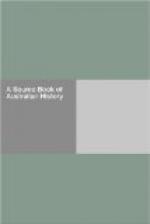From them we learned what had happened in those first wild moments. All the tows had almost reached the beach, when a party of Turks, entrenched almost on the shore, opened up a terrible fusillade from rifles and also from a Maxim. Fortunately most of the bullets went high, but, nevertheless, many men were hit as they sat huddled together forty or fifty in a boat.
It was a trying moment, but the Australian volunteers rose as a man to the occasion. They waited neither for orders, nor for the boats to reach the beach, but, springing out into the sea, they waded ashore, and, forming some sort of a rough line, rushed straight on the flashes of the enemy’s rifles. Their magazines were not charged, so they just went in with cold steel, and I believe I am right in saying that the first Ottoman Turk since the last Crusade received an Anglo-Saxon bayonet in him at 5 minutes after 5 a.m. on April 25th. It was over in a minute. The Turks in this first trench were bayoneted or ran away, and a Maxim gun was captured.
Then the Australians found themselves facing an almost perpendicular cliff of loose sandstone, covered with thick shrubbery, and somewhere half-way up the enemy had a second trench strongly held, from which they poured a terrible fire on the troops below, and the boats pulling back to the destroyers for the second landing party.
Here was a tough proposition to tackle in the darkness, but these Colonials are practical above all else, and they went about it in a practical way. They stopped a few moments to pull themselves together, and to get rid of their packs which no troops could carry in an attack, and then charged their magazines. Then this race of athletes proceeded to scale the cliffs without responding to the enemy’s fire. They lost some men but did not worry, and in less than a quarter of an hour the Turks were out of their second position, either bayoneted or in full flight.
This ridge under which the landing was made, stretches due north from Gaba Tepe, and culminates in the height of Coja Chemen, which rises 950 feet above the sea level. The whole forms part of a confused triangle of hills, valleys, ridges, and bluffs which stretches right across the Gallipoli Peninsula to the Bay of Bassi Liman, above the Narrows. The triangle is cut in two by the valley through which flows the stream known as Bokali Deresi....
In the early part of the day very heavy casualties were suffered in the boats which conveyed the troops from the destroyers, tugs, and transports to the beach. As soon as it became light, the enemy’s sharpshooters, hidden everywhere, simply concentrated their fire on the boats....
Throughout the whole of April 25th the landing of troops, stores, and munitions had to be carried out under these conditions, but the gallant sailors never failed their equally gallant comrades ashore. Every one, from the youngest midshipman straight from Dartmouth and under fire for the first time, to the senior officers in charge, did their duty nobly....




